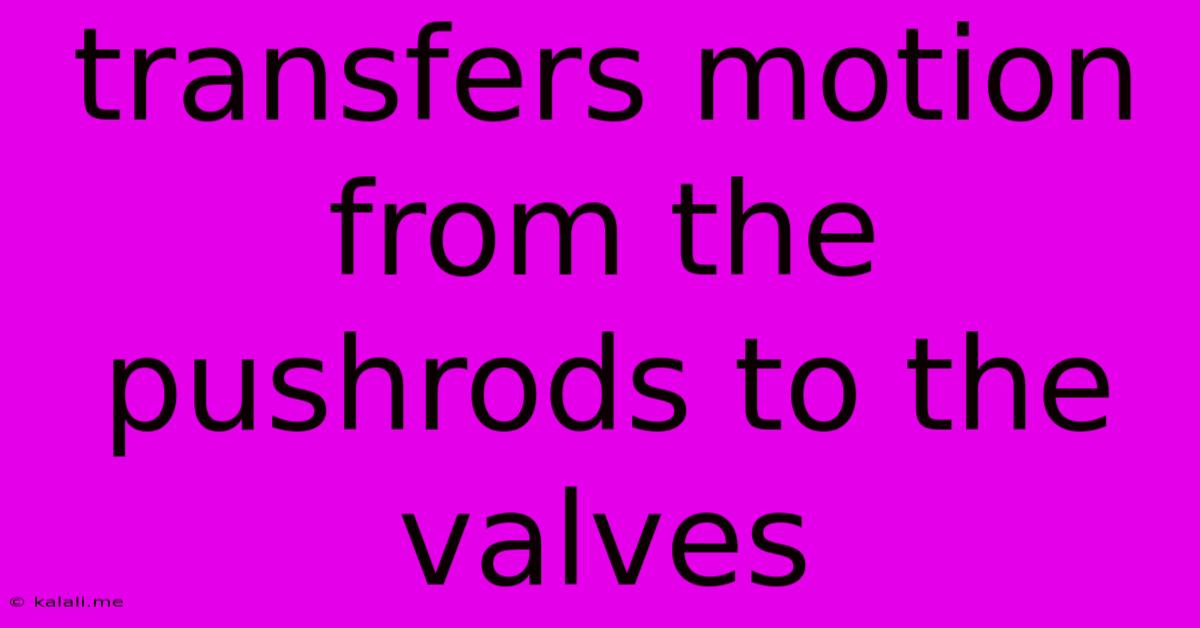Transfers Motion From The Pushrods To The Valves
Kalali
Jun 13, 2025 · 3 min read

Table of Contents
Transferring Motion: How Pushrods Activate Engine Valves
This article delves into the intricate mechanism of transferring motion from pushrods to valves in an internal combustion engine. Understanding this process is crucial for anyone interested in automotive mechanics, engine design, or simply the inner workings of a vehicle. We'll explore the components involved, the sequence of events, and the importance of precise operation for optimal engine performance.
What are Pushrods and Their Role?
Pushrods are slender rods, typically made of steel, that form a crucial link in the valve actuation system of many engines, particularly those with overhead valve (OHV) designs. Unlike overhead camshaft (OHC) engines where the camshaft directly actuates the valves, pushrods act as intermediaries, transmitting the motion from the camshaft (located lower in the engine block) to the rocker arms, which in turn operate the valves. This system is known for its simplicity and robustness.
Components of the Pushrod Valve Actuation System:
- Camshaft: The heart of the system, the camshaft rotates and its lobes lift the pushrods at precisely timed intervals. The camshaft's profile determines the duration and lift of the valves.
- Pushrods: These rods directly receive the upward motion from the camshaft lobes. Their length is critical for proper valve operation.
- Rocker Arms: These levers amplify and translate the pushrod's vertical motion into the rocking motion needed to open and close the valves. They often incorporate a fulcrum point for mechanical advantage.
- Valves: The final components; intake and exhaust valves that control the flow of air and exhaust gases into and out of the combustion chamber. Precise valve timing is essential for engine efficiency and power.
- Valve Springs: These springs constantly push the valves closed, ensuring they seat properly after the rocker arm has completed its downward stroke. They are critical for preventing valve float at high engine speeds.
- Lifters/Tappets: These components sit between the camshaft lobes and the pushrods. They compensate for wear and maintain consistent valve clearance. Hydraulic lifters automatically adjust valve clearance, while solid lifters require periodic adjustment.
The Sequence of Events: From Camshaft to Valve
- Camshaft Rotation: The camshaft rotates, driven by the engine's crankshaft.
- Cam Lobe Contact: As the camshaft rotates, a lobe on the cam contacts the lifter or tappet.
- Pushrod Movement: This contact lifts the lifter and pushes the pushrod upwards.
- Rocker Arm Actuation: The upward movement of the pushrod pushes on the rocker arm, causing it to pivot.
- Valve Opening: The rocker arm's movement lifts the valve, allowing air or exhaust gases to flow.
- Valve Closure: Once the cam lobe passes, the valve spring forces the valve back down, closing it. The rocker arm and pushrod follow, returning to their resting position.
Importance of Precise Operation:
The precise timing and movement of each component are crucial for optimal engine performance. Improper valve timing can lead to reduced power, poor fuel economy, and even engine damage. Factors like pushrod length, valve clearance, and camshaft profile all play a significant role in achieving this precision. Wear and tear on components can affect this precision, emphasizing the need for regular maintenance and inspection.
Troubleshooting Common Issues:
Problems within the pushrod system can manifest as a range of issues, from misfires to noisy operation. Understanding the system allows for more effective troubleshooting. Common problems include:
- Bent pushrods: Can lead to uneven valve lift or valve failure.
- Worn lifters/tappets: Can cause valve train noise and inconsistent valve operation.
- Incorrect valve adjustment: Can result in improper valve timing and decreased engine performance.
- Broken valve springs: Causes valves to stay open or close incorrectly, potentially leading to catastrophic engine damage.
Understanding the intricate mechanics of how pushrods transfer motion to valves offers valuable insight into the engineering marvel that is the internal combustion engine. The system's simplicity and effectiveness have cemented its place in automotive history, and appreciation for its role in engine functionality is essential for any aspiring or seasoned mechanic.
Latest Posts
Latest Posts
-
Which Of The Following Statements About The Moon Is True
Jun 14, 2025
-
Greatest Common Factor Of 84 And 105
Jun 14, 2025
-
How Many Moles Of Aluminium Sulphate
Jun 14, 2025
-
Stress Strain Graph For Cast Iron
Jun 14, 2025
-
Difference Between American Culture And Indian Culture
Jun 14, 2025
Related Post
Thank you for visiting our website which covers about Transfers Motion From The Pushrods To The Valves . We hope the information provided has been useful to you. Feel free to contact us if you have any questions or need further assistance. See you next time and don't miss to bookmark.